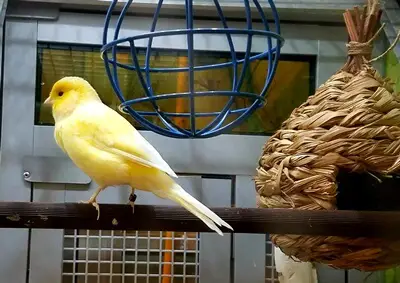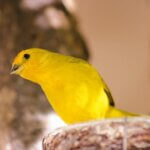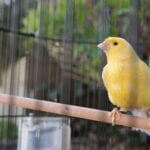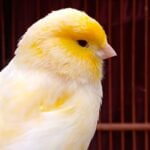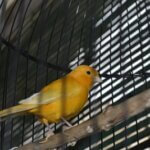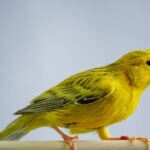Canaries have a respiratory system that allows oxygen in and lets carbon dioxide out — all in one breath. This is called unidirectional airflow.
They have muscles that push the ribs and keel down and forward so that carbon dioxide is expelled while fresh oxygen enters the lungs.
Because canaries breathe so efficiently, it’s rare for them to gasp for air.
When this happens, you must intervene since heavy or difficult breathing can be an urgent symptom. If ignored, it may even be fatal for your canary.
How Fast Do Canaries Breathe?
A canary needs to breathe 60-100 times per minute. Your canary may be on the lower end of that range since it doesn’t need to fly as much as it does in the wild.
However, you won’t need to count breaths to know if your canary is panting. A canary breathing too fast will manifest other distress symptoms.
What Does Gasping For Air Look Like?
Dyspnea is a condition wherein a canary has difficulty breathing. Dyspnea has many causes, but each will present itself in symptoms like:
Opening Mouth
A canary is experiencing trouble breathing if its mouth is open. Otherwise, it may be out of breath from physical exertion, like hopping around or flying.
An open mouth allows a canary to draw more air into its body. In normal situations, breathing through the nose should be sufficient.
Wheezing
Wheezing noises are a strong indicator that your canary is suffering from an infection in its respiratory system. Because of how complicated and delicate a canary’s respiratory system is, this species is prone to a wide range of lung infections, and some are graver than others.
Panting
Canaries with an obstruction in their throats will likely pant for air, which can be paired with an open mouth and frantic movements.
Tail Bobbing
A canary may bob its tail up and down when it’s having trouble breathing. A few quick bobs may indicate a canary is about to poop, but insistent or frantic bobbing can signify pain.
Why Is My Canary Gasping For Air?
To assist a canary, you must understand why it’s gasping for air. This panicked response may be the result of the following:
Stress
Extreme stress may cause canaries to gasp for breath. This is true whether the canary has been frightened, engaged in a fight among birds, or feels trapped.
If your canary is gasping for air, that doesn’t automatically mean it’s injured, and it might have just gone through a harrowing experience and is trying to calm down.
Quickly check over your canary to ensure it’s not injured. Then, move it to a cool, quiet room where it can recover. You can also place a blanket over its cage if the canary dislikes being moved. Keep your voice down and remain calm.
The canary’s breathing should return to normal in a couple of minutes. If it doesn’t, check to see if there are other reasons why your canary is breathing heavily.
Overheating
Canaries that pant may have heat stress. This will be paired with symptoms like:
- Fluffed-up feathers: This is an attempt to insulate the bird from heat. If the canary is still overheated, its wings will droop.
- Standing with legs slightly apart: This is to increase airflow against the skin, especially the feet, where the skin is exposed
You can help to overheat canaries by:
- Placing the canary in a cooler area
- Misting the canary with room-temperature water
- Placing your canary on a damp towel or a shallow dish of room-temperature water
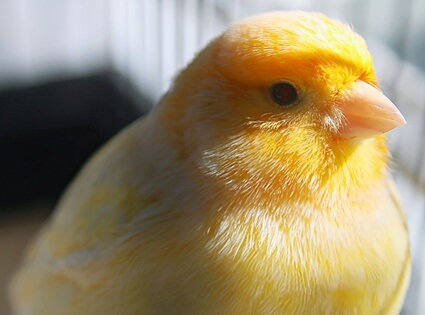
Obstruction of The Trachea
A tracheal obstruction is when a canary chokes on its food. However, it can also refer to anything that blocks a canary’s trachea, causing it to gasp for air.
You’ll know a canary is choking if it extends its neck. This is meant to dislodge the obstruction, which could be matched to a small coughing sound.
The most common reason for a blocked trachea is when a canary chokes on seeds. Other reasons include the following:
- Swelling of the trachea due to parasitic, fungal, and bacterial infections.
- Trauma to the trachea.
- Swelling around the trachea, like in the thyroid gland.
Don’t perform the Heimlich maneuver if you think your canary is choking. The canaries are too small and lack a diaphragm. Vets suggest inverting the bird without restraining the head to let gravity help.
Even if the object has been dislodged, seek veterinary care. Bring your canary to a vet immediately if it hasn’t been dislodged. According to the Journal of Avian Medicine and Surgery, a vet may do a tracheotomy or prescribe medicines to prevent secondary infections.
Respiratory Diseases
Panting is a symptom of many respiratory diseases. Because of a canary’s sensitive lungs and air sacs, this species is prone to ailments in all its forms.
Air Sac Mites
Various air sac mites can affect canaries, including the cytodites nudus and the sternostoma tracheacolum. Mites can be easily transmitted from bird to bird, even if they aren’t the same species.
The cytodites nudus can also infect:
- Chicken
- Turkeys
- Pheasants
- Pigeons
- Mallards
Air sac mites live inside the respiratory and abdominal systems of affected birds. They can be seen as a small white spots only when birds are internally examined.
Aside from panting and open-mouth breathing, symptoms of air sac mites include:
- Breathing problems
- Excessive salivation
- Tail bobbing
- Weakness
- Weight loss
- Pneumonia
- Swelling of the belly or abdomen
- Pulmonary edema
When left untreated, it can cause death. In severe cases, birds will have to be euthanized. However, vets will prescribe ivermectin or inhalation of insecticidal dust if caught early.
Canarypox
Poxviruses are a virus that can affect different bird species. Each can have its unique pox virus, such as canarypox. The canarypox virus is often shortened to CNPV. It can be transmitted through:
- Mosquitoes and mite bites
- Eating infected scabs
- Inhalation of the virus
There are two main forms in that canary pox can appear as:
- Dry or skin form: The exposed skin on birds begins to turn whitish or yellowish. Eventually, this will form crusts. It often affects the legs, feet, face, eyes, and beak.
- Wet or throat form: The mouth, throat, and sinuses become thickened with plaques.
Other symptoms of canarypox include:
- Rapid breathing
- Sudden labored breathing
- Fluffed-up feathers
- Weight loss
- Weakness
There’s no cure for canarypox, which is often fatal, especially when the virus has run its course. Canarypox has a high mortality rate because its symptoms can fly under the radar, and death can be sudden.
However, some canaries have light symptoms, and others fully recover from their ailment. Vet treatment can include preventing infection of the scabs on the skin and prescribing antibiotics and probiotics.
Birds with canarypox can never mix with other birds. Thankfully, canaries are loners.
Aspergillosis
Aspergillosis is a common cause of respiratory diseases in birds, and it happens when the aspergillus fungus spores enter a canary’s body.
Unlike most respiratory diseases, aspergillosis isn’t transmitted from bird to bird. Rather, the fungus lives in a dirty environment, such as in dust, dirt, and mold.
Canaries must have a weakened immune system to be affected. Healthy birds can breathe in small amounts of spores without contracting aspergillosis. However, even healthy canaries can become sick if they breathe in enough spores.
Because fungal spores are inhaled, it often affects the respiratory system. Even still, aspergillosis can affect any body organ by traveling through the bloodstream or an air sac. Aspergillosis has these symptoms:
- Difficulty breathing
- Tail bobbing
- Weight loss
- Lethargy
- Listlessness
- Fluffed-up feathers
To treat canaries, vets will prescribe an antifungal medication. This can be given orally, topically, or through an aerosol. Veterinarians may also remove fungal plaques through surgery.

